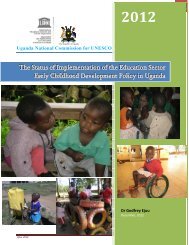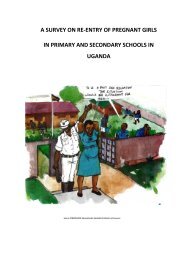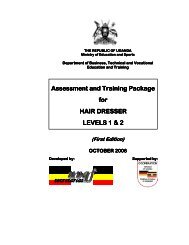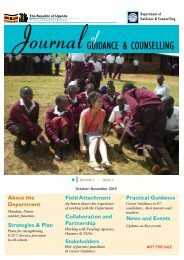Download Pdf - Ministry of Education and Sports
Download Pdf - Ministry of Education and Sports
Download Pdf - Ministry of Education and Sports
You also want an ePaper? Increase the reach of your titles
YUMPU automatically turns print PDFs into web optimized ePapers that Google loves.
During the period under review, the percentage share <strong>of</strong> female students to total enrolment in higher<br />
education increased by 0.8%age points from 43.85% in financial year 2010/11 to 56.2% in financial<br />
year 2011/12 as indicated in Table 4.20.<br />
Table: 4.20.Percentage enrolment <strong>of</strong> students by gender<br />
FY Male Female<br />
2010/11 43.9% 56.2%<br />
2011/12 56% 43.8%<br />
Source: EMIS 2011<br />
59<br />
(d)<br />
(i)<br />
(ii)<br />
(iii)<br />
(iv)<br />
Challenges <strong>and</strong> constraints<br />
Inadequate resources for salary enhancement for University lecturers, leading to great attrition<br />
rates.<br />
Inadequate resources to raise staff levels at Public Universities to at least 50% for academic<br />
staff.<br />
Constant GoU recurrent visavis increasing inflation <strong>and</strong> cost <strong>of</strong> living. This affects education<br />
delivery.<br />
Inadequate classrooms, ICT labarotories, library <strong>and</strong> <strong>of</strong>fice space at Ug<strong>and</strong>a Management<br />
Institute.<br />
4.2 QUALITY<br />
During FY 2011/12, the <strong>Education</strong> Sector continued to implement a number <strong>of</strong> policy interventions<br />
across all sub sectors to improve the quality <strong>of</strong> education in Ug<strong>and</strong>a. These included; Monitoring &<br />
support supervision; teacher training <strong>and</strong> development; Procurement <strong>of</strong> instructional materials;<br />
Implementation <strong>of</strong> policies, laws, guidelines, plans <strong>and</strong> strategies; Curriculum development,<br />
implementation <strong>and</strong> review; infrastructure development, among others. Achievements <strong>and</strong> out comes<br />
under each sub sector are presented in this chapter.<br />
4.1.1 Pre‐primary <strong>and</strong> Primary <strong>Education</strong><br />
During the period under review, improving the quality <strong>of</strong> PrePrimary <strong>and</strong> primary education<br />
remained one <strong>of</strong> the major policy thrusts for the Subsector. This is clearly reflected in the policy<br />
objectives <strong>and</strong> priorities i.e. to provide support supervision to education managers so as to ensure<br />
provision <strong>of</strong> quality education as well as improve learning achievement in literacy <strong>and</strong> numeracy; to<br />
assist districts to improve the completion rate in primary schools; to progressively enable children<br />
aged 35 years old exercise their right to quality learning, stimulation <strong>and</strong> preparation for timely<br />
enrolment in primary; to enable children aged 612 years old especially girls complete quality primary<br />
education <strong>and</strong> achieve the required pr<strong>of</strong>iciency levels; to improve the Pupil to Classroom Ratio (PTR);<br />
<strong>and</strong> to establish centers <strong>of</strong> excellence in Karamoja region. These policy objectives guided action in the<br />
sub sector during the period under review, hence a number <strong>of</strong> interventions as indicated below;<br />
(a) Interventions undertaken to enhance quality during FY 2011/2012<br />
The interventions undertaken by the subsector during the period under review are summarised in<br />
Box 4.5 below;<br />
ESSAPR FY 2011/12 to inform the 19 th ESSR – OCTOBER 2012








